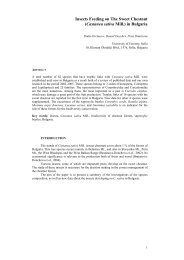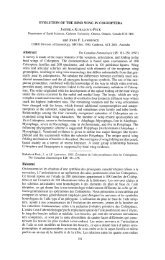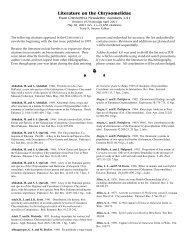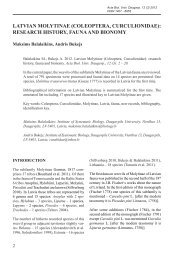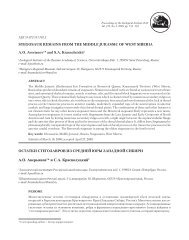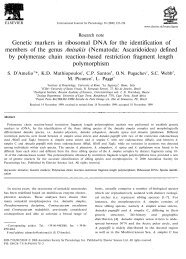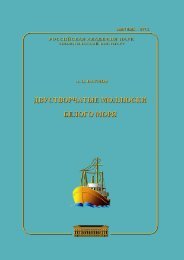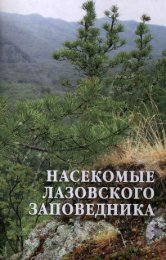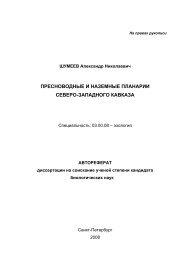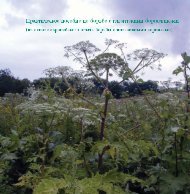Revision of the genus Mniophila STEPHENS, 1831
Revision of the genus Mniophila STEPHENS, 1831
Revision of the genus Mniophila STEPHENS, 1831
You also want an ePaper? Increase the reach of your titles
YUMPU automatically turns print PDFs into web optimized ePapers that Google loves.
Beitr. Ent. 59 (2009) 1105SystematicsGenus <strong>Mniophila</strong> <strong>STEPHENS</strong>, <strong>1831</strong><strong>Mniophila</strong> <strong>STEPHENS</strong>, <strong>1831</strong>: 330. – HEIKERTINGER 1930: 1346 (catalogue). – HEIKERTINGER & CSIKI1940: 520–522 (world catalogue). – KASZAB 1962: 349 (key, description). – MOHR 1966: 206, 261,fig 70: 1 (key). – GRUEV & TOMOV 1986: 312–314, figs 358, 359a, b (key, description). – DOGUET1994: 549–552, figs 208, 209 (key, description). – KONSTANTINOV & VANDENBERG 1996: 271, 307,fig. 48 (key, description). – COX 1997: 277–279, figs 1–6 (egg, larva). – GRUEV & DÖBERL 1997:240–241 (distribution, bibliography). – WARCHAŁOWSKI 2000: 25–28, figs 35–40 (key, description,distribution).Type species: Haltica muscorum KOCH, 1803, by monotypy.Distribution:Range <strong>of</strong> distribution <strong>of</strong> <strong>the</strong> <strong>genus</strong> <strong>Mniophila</strong> embraces Western and Central Europe, Balkans,Crimea, Caucasus, and Turkey (Figs 8-10). <strong>Mniophila</strong> muscorum has <strong>the</strong> widest range (Fig. 8), fromPyrenees (Spain) to Carpathians (Ukraine). The nor<strong>the</strong>rn boundary <strong>of</strong> this species is in Dania,Norway, and Sweden. The rest <strong>of</strong> <strong>the</strong> species have ranges smaller than <strong>Mniophila</strong> muscorum. It isworthy to mention <strong>the</strong> high level <strong>of</strong> endemism among <strong>the</strong> species <strong>of</strong> <strong>Mniophila</strong>. The only ranges<strong>of</strong> M. muscorum and M. bosnica, and probably, M. caucasica sp. n. and M. transcaucasica sp. n. arepartly overlapping (Figs 8-10).Redescription:Body dark, brown to black, shining, with greenish or bronzy metallic luster or without one;sometimes in brown individuals pronotum and elytra with light margin; sometimes partlycoloured individuals occur; legs and antennae light to dark brown. Body elliptical and moderatelyconvex to clearly rounded and ra<strong>the</strong>r convex (Figs 1A-E; 3A-C; 4A; 5A, B; 6A-D; 7A); head notor barely visible from above. Head (Figs 1F; 4H; 5C; 7E) large; vertex large, wide, its surfacecovered with weakly developed smooth shagrination coarse, well developed, grainy shagrination.Ocular sulci not developed. Frontal calli triangular or rhomboidal, small, its surface smoo<strong>the</strong>rthan that <strong>of</strong> <strong>the</strong> vertex and frons; separated from vertex by thin supracallinal sulci. Frontal ridgedistinct, convex, triangular and flattened basally. Anter<strong>of</strong>rontal ridge weakly convex, straight.Antennal grooves large and deep, covered with large and coarse shagrination. Frontal part <strong>of</strong> headmoderately short to long. Antennal sockets situated closely to each o<strong>the</strong>r, separated from eyemargin by impressed interval in length is almost equal to socket. Eyes small, elliptical, flattenedto convex, widely spaced. Antennae (Figs 1M, 3D; 4G; 5E; 6K; 7D) short; three apical segmentsdistinctly widened; remaining segments thinner; eighth antennomere thinner and smaller thanseventh; first and second antennomeres clearly longer and thicker than following five segments.Labrum small, with deep frontal notch situated medially.Pronotum (Figs 1G; 3E, 4B; F; 6E; 7B) large, widely transverse. Apical and basal edges withra<strong>the</strong>r thin margins; lateral margin wider. Anter<strong>of</strong>rontal callosity large, thickened, not formingacute denticle; posterolateral callosity smaller, poorly developed. Basal edge <strong>of</strong> pronotum curvedin sides, distinctly rounded medially or widely rounded. Pronotal surface covered with visible,large shagrination. Punctation usually present, not coarse, sparse, and shallow, poorly visible onpronotal microsculpture, rarely impunctate.Elytra slightly elongate with elongate elytral apices to clearly rounded, without elongate apices.Punctation variable: impunctate to punctured densely; usually punctures arranged in regular orpartly confused striae, depth and frequency, and size <strong>of</strong> punctures variable; secondary punctation




